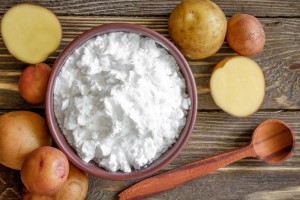Potato starch – also known as potato flour – is extracted from potatoes. The cells of the root tubers of the potato plant contain starch granules (leucoplasts). To extract the starch, the potatoes are crushed and the starch grains are released from the cells. The starch is then washed out and dried to powder. Potato starch has been produced in the same basic way for centuries – actually even the ancient Incas knew how to make potato starch
Contents
Uses
- Starch derivatives are used in many recipes, for example in noodles, wine gums, cocktail nuts, potato chips, hot dog sausages, bakery cream and instant soups and sauces, in gluten-free recipes[3]in kosher foods for Passover[4] and in Asian cuisine.[5] In pastry, e.g. sponge cake, it is used to keep the cake moist and give a soft texture. It is also occasionally used in the preparation of pre-packed grated cheese, to reduce sweating and binding.
- Other examples are helmipuuro, a porridge made from monodisperse grains of potato starch and milk, and papeda (the Moluccan community in the Netherlands uses potato starch to make papeda). It is also used in technical applications as wallpaper adhesive, for textile finishing and textile sizing, in paper coating and sizing, and as an adhesive in paper sacks and gummed tape.
- Potato starch was also used in one of the earlier color photography processes, the Lumière brothers’ Autochrome Lumière, until the arrival of colour film in the mid-1930s.
Benefits
- Potato starch contains typical large oval spherical granules; their size ranges between 5 and 100 μm. Potatoes’ starch granules are roughly twice as big as other starch granules (tapioca or grain starches) resulting in much higher water absorption capacity and better texture. Potato starch is a very refined starch, containing minimal protein or fat. This gives the flour a clear white colour, and the cooked starch typical characteristics of neutral taste, good clarity and transparency, high binding strength, long texture and a minimal tendency to foaming or yellowing of the solution.Potato starch contains approximately 800 ppm phosphate bound to the starch; this increases the viscosity and gives the solution a slightly anionic character, a low gelatinisation temperature (approximately 60 °C) and high swelling power. These typical properties are used in food and technical applications.
Potatoes’ starch granules are roughly twice as big as other starch granules (tapioca or grain starches) resulting in much higher water absorption capacity and better texture.
Untreated starch requires heat to thicken or gelatinize. When a starch is pre-cooked, it can then be used to thicken instantly in cold water. Pre-gelatinized potato starch is starch cooked and then dried on a drum dryer or in an extrudermaking the starch cold water soluble. This is a physical modification of the starch. The starch remains a native starch and can be declared as such. Aloja Starkelsen SIA produces drum-dried pre-gelatinized or cold-swelling potato starch. Chemically modified starches are not allowed in organic food processing
Applications
As an additive for food processing, food starches are typically used as thickeners and stabilizers in foods such as puddings, custards, soups, sauces, gravies, pie fillings, and salad dressings, and to make noodles and pastas. Potato starch may be used in all traditional recipes replacing any other starch – and in most cases giving better functionality. Organic potato starch adapts extremely well to organic processing.
Potato starch is used as:- Water binder
- Thickener
- Anti caking ingredient
- Bulking ingredient
- Glueing agent
The most popular application areas are in:
- Meat industry
- Bakeries
- Confectionery
- Dry blends
Potato starch and potato starch derivatives are used in many recipes, for example in noodles, wine gums, cocktail nuts, potato chips, hot dog sausages, bakery cream and instant soups and sauces, in gluten-free recipes, in kosher foods for Passover and in Asian cuisine. In pastry, e.g. sponge cake, it is used to keep the cake moist and give a soft texture. It is also occasionally used in the preparation of pre-packed grated cheese, to reduce sweating and binding. Helmipuuro, traditionally consumed in Finland, is a porridge made from monodisperse grains of potato starch and enjoyed with milk. The Helmi potato granules are produced by Finnamyl Ltd.
- Fresh dairy spreads…
- Fresh dairy desserts and ice cream…
- Fruit preparations…
- Cured meats and poultry…
- Bread and pastry…
- Snacks…
Native starch requires heat to thicken or gelatinize. When a starch is pre-cooked, it can then be used to thicken instantly in cold water. This is referred to as a cold-swelling (CS) or pregelatinized starch.
Cautions
Please talk to your nutritionist
Interactions
N/A
Other names
potato flour
References
Source: Wikipedia, https://en.wikipedia.org/wiki/Potato_starch#Use
DietDoctor, http://www.dietdoctor.com/potato-starch-lchf-resistant-starch


Hey very nice web site!! Man.. Beautiful.. Wonderful.. I’ll bookmark your web site and take the feeds. Thank you for sharing!